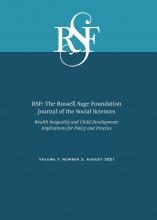Research Article
Open Access
Investment, Saving, and Borrowing for Children: Trends by Wealth, Race, and Ethnicity, 1998–2016
Nina Bandelj, Angelina Grigoryeva
RSF: The Russell Sage Foundation Journal of the Social Sciences August 2021, 7 (3) 50-77; DOI: https://doi.org/10.7758/RSF.2021.7.3.03
Nina Bandelj
aProfessor of sociology and associate vice provost for faculty development at the University of California, Irvine, United States
Angelina Grigoryeva
bAssistant professor in the Department of Sociology at the University of Toronto, Canada

REFERENCES
- ↵
- Akers, Beth, and
- Matthew Chingos
- ↵
- ↵
- Bagwell, Laurie S., and
- Douglas B. Bernheim
- ↵
- Bandelj, Nina
- ↵
- Bandelj, Nina,
- Frederick F. Wherry, and
- Viviana A. Zelizer
- ↵
- Baradaran, Mehrsa
- ↵
- Barba, Aldo, and
- Massimo Pivetti
- ↵
- Bianchi, Suzanne,
- Philip N. Cohen,
- Sara Raley, and
- Kei Nomaguchi
- ↵
- Bianchi, Suzanne M.,
- John P. Robinson, and
- Melissa A. Milke
- ↵
- Board of Governors of the Federal Reserve System (Federal Reserve)
- ↵
- Brown, Meta,
- Andrew Haughwout,
- Donghoon Lee,
- Joelle Scally, and
- Wilbert van der Klaauw
- ↵
- Bucks, Brian K
- ↵
- ↵
- Carr, Christopher
- ↵
- ↵
- Charles, Kerwin Kofi,
- Erik Hurst,
- Nikolai Roussanov
- ↵
- Chin, Tiffani, and
- Meredith Phillips
- ↵
- Cohen, Joseph
- ↵
- College Savings
- ↵
- Collins, Jane L
- ↵
- Cooper, Marianne
- ↵
- Davis, Gerald F
- ↵
- ↵
- Doepke, Matthias, and
- Fabrizio Zilibotti
- ↵
- Dow, Dawn
- ↵
- ↵
- Edin, Kathryn, and
- Timothy J. Nelson
- ↵
- Elliott, Sinikka,
- Rachel Powell, and
- Joslyn Brenton
- ↵
- ↵
- Epstein, Gerald A
- ↵
- Feliciano, Cynthia, and
- Yader R. Lanuza
- ↵
- Fishman, Rachel
- ↵
- ↵
- Frank, Robert
- ↵
- Frank, Robert
- ↵
- Friedman, Zach
- ↵
- ↵
- ↵
- Glick, Jennifer E., and
- Michael J. White
- ↵
- Goyette, Kimberly, and
- Yu Xie
- ↵
- Grigoryeva, Angelina
- ↵
- ↵
- Hays, Sharon
- ↵
- Holden, Sarah
- ↵
- Houle, Jason
- ↵
- Immerwahr, John, and
- Tony Foleno
- ↵
- Ishizuka, Patrick
- ↵
- Johnson, Heather Beth
- ↵
- Kalil, Ariel,
- Rebecca Ryan, and
- Michael Corey
- ↵
- Kalleberg, Arne L
- ↵
- Kao, Grace, and
- Marta Tienda
- ↵
- ↵
- Killewald, Alexandra,
- Fabian T. Pfeffer, and
- Jared N. Schachner
- ↵
- Kornrich, Sabino, and
- Frank Furstenberg
- ↵
- ↵
- Krippner, Greta R
- ↵
- ↵
- Lareau, Annette
- ↵
- Lea, Stephen E.G.,
- Paul Webley, and
- R. Mark Levine
- ↵
- Leicht, Kevin
- ↵
- Leicht, Kevin, and
- Scott Fitzgerald
- ↵
- Leicht, Kevin, and
- Scott Fitzgerald
- ↵
- Lin, Ken-Hou, and
- Megan Tobias Neely
- ↵
- Ma, Jennifer
- ↵
- Manning, Robert D
- ↵
- Maroto, Michelle
- ↵
- Martin, Randy
- ↵
- McKernan, Signe-Mary,
- Caroline Ratcliffe,
- Eugene Steuerle, and
- Sisi Zhang
- ↵
- Montgomerie, Johnna
- ↵
- ↵
- Moore, Mignon
- ↵
- National Center for Education Statistics (NCES)
- ↵
- Nelson, Margaret
- ↵
- ↵
- Pager, Devah, and
- Hana Shepherd
- ↵
- Pellandini-Simányi, Léna,
- Ferenc Hammer, and
- Zsuzsanna Vargha
- ↵
- Percheski, Christine, and
- Christina Gibson-Davis
- ↵
- ↵
- Porter, Katherine
- ↵
- Prasad, Monica
- ↵
- Pressman, Steven, and
- Robert Scott
- ↵
- Rajan, Raghuram G
- ↵
- Ramey, Garey, and
- Valerie A. Ramey
- ↵
- Ritzer, George
- ↵
- Ritzer, George
- ↵
- ↵
- ↵
- Schneider, Daniel,
- Orestes P. Hastings, and
- Joe LaBriola
- ↵
- Schor, Juliet B
- ↵
- Schor, Juliet B
- ↵
- Seamster, Louise, and
- Raphael Charron-Chenier
- ↵
- Shapiro, Thomas M
- ↵
- Shapiro, Thomas M
- ↵
- Sullivan, Teresa, and
- George Kaufman
- ↵
- Trigg, Andrew B
- ↵
- Turetsky, Vicki, and
- Maureen R. Waller
- ↵
- Turner, Jennifer
- ↵
- Urban Institute
- ↵
- Veblen, Thorstein
- ↵
- ↵
- Warren, Elizabeth, and
- Deborah Thorne
- ↵
- Warren, Elizabeth, and
- Amelia Tyagi
- ↵
- Weber, Max
- ↵
- ↵
- Western, Bruce,
- Deirdre Bloome, and
- Christine Percheski
- Wightman, Patrick,
- Robert F. Schoeni, and
- Keith Robinson
- ↵
- Wisman, Jon D
- ↵
- Wolff, Edward N
- ↵
- Wolff, Edward N
- ↵
- Wolff, Edward N
- ↵
- Zaloom, Caitlin
- ↵
- ↵
- Zelizer, Viviana
In this issue
Investment, Saving, and Borrowing for Children: Trends by Wealth, Race, and Ethnicity, 1998–2016
Nina Bandelj, Angelina Grigoryeva
RSF: The Russell Sage Foundation Journal of the Social Sciences Aug 2021, 7 (3) 50-77; DOI: 10.7758/RSF.2021.7.3.03
Jump to section
Related Articles
- No related articles found.
Cited By...
- No citing articles found.





